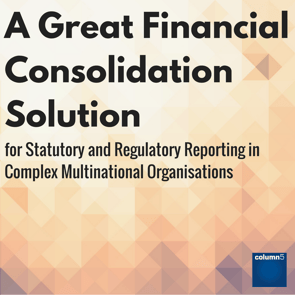SAP has a portfolio of Consolidation solutions with their own unique positioning and the SAP Financial Consolidation (FC) software is an enterprise solution offered to companies looking to improve and speed up their financial close – without sacrificing quality control and compliance.
FC became part of the SAP EPM portfolio through the acquisition of BusinessObjects in 2007. BusinessObjects itself acquired the French software vendor Cartesis who originally marketed Financial Consolidation as Cartesis Magnitude. With a large and loyal customer base throughout Europe and Japan, FC has a particularly strong focus on statutory consolidation requirements within large multinational organisations that have complex and evolving corporate structures across multiple reporting standards (e.g. IFRS and local GAAP).
 Beyond the traditional statutory consolidation market, FC is also used to collect and consolidate data required for non-standard and regulatory reporting, for example European Solvency II and Common Reporting frameworks for the Insurance and Banking industries respectively. This is particularly well suited to the FC tool where there are common and very detailed data sets shared between regulatory and statutory reports. The application also supports the consolidation of Budgets, Plans and Forecasts.
Beyond the traditional statutory consolidation market, FC is also used to collect and consolidate data required for non-standard and regulatory reporting, for example European Solvency II and Common Reporting frameworks for the Insurance and Banking industries respectively. This is particularly well suited to the FC tool where there are common and very detailed data sets shared between regulatory and statutory reports. The application also supports the consolidation of Budgets, Plans and Forecasts.
FC has a strong focus on transparency and auditability; through the use of standard dimensions FC is equipped to enable users to trace the origin of data and adjustments throughout the consolidation process.
By using SAPs Rapid Deployment Solutions and Starter Kit, customers can be up and running with an enterprise consolidation solution within a short time-frame, reducing effort and costs. SAP provide the content within the application (data entry environment, input forms, calculations) that are necessary for the customer’s reporting requirement. Some of the solutions in scope are, for example IFRS, US GAAP, European Solvency II and Financial Reporting for Banking (FINREP) regulatory reporting.
Related Content: Tax Reporting Just Got a Whole Lot Tougher! (Thanks to the OECD)
FC is integrated with other tools in the SAP EPM portfolio, allowing customers to improve the financial close process end to end. The Financial Information Management (FIM) application provides a simple and intuitive tool for finance users to maintain mappings and data integration into and between FC and other EPM products (Intercompany, BPC) as well as for sourcing data from other ERP systems, all with comprehensive audit trails.
The Intercompany application (IC) provides peer-to-peer, real time reconciliation of intercompany balances (down to invoice level) which can be automatically integrated into the FC data entry environment.
Disclosure Management (DM) provides the last mile in reporting, necessary for managing the production of large scale external and regulatory reports (such as SEC filings and the Annual Report and Accounts) and has direct connectors from FC to provide the finalised auditable consolidated data.
Regulatory and non-standard reporting
The topic of Regulatory Reporting is coming increasingly to the fore; for example Country by Country Tax Reporting in Europe (the new OECD globally mandated requirement), FINREP and COREP for banks or Solvency II compliance for insurance institutions in Europe. Furthermore there are increasing demands on companies to provide information on areas that are traditionally outside the remit of the Finance function such as sustainability reporting. As reporting complexity grows, FC is an ideal platform for bringing this data together in a controlled, auditable and high performing environment.

The benefit of using FC for these types of reporting is that organisations can enrich or aggregate statutory consolidated data in line with requirements of the regulators.
By including these processes in FC, organisations benefit in key areas: automated validation of regulatory data back to Balance Sheet and P&L, reporting at legal entity (solo) as well as consolidated (group) level, automated integration of data with SAP XBRL solutions and subscription to SAP business content (for example regulatory XBRL taxonomies).
The high number of user defined dimensions and instances available to customers ensures that a sustainable model can be built which supports all reporting objectives. SAP FC is able to store up to 18 user defined dimensions per instance with almost unlimited scope for reporting and budgeting/planning scenarios.
The final benefit is the high quality of control and auditability of the data and the automation of the complex accounting adjustments needed to perform equity elimination, minority interest calculations and other accounting consolidation adjustments in the most complex of corporate ownership structures. These calculations can be built with standard functionality directly in the application by the Finance function– no scripting or involvement from IT departments is required.
Looking ahead
FC is fully compatible with third party database providers MS SQL Server and Oracle as well as SAP HANA in-memory technology. As such, it is equally suitable for existing SAP or non-SAP customers.

Regardless of the underlying technology customers will benefit from the powerful consolidation engine when it comes to performance of the application. A clear benefit of the application is that it provides impressive performance of processing complex consolidation rules for those customers who run full consolidations on a scheduled and ad hoc basis throughout the reporting period.
Lately SAP have been making investment in the tool and version 10.1 is a major release milestone. Next to technical and functional improvements, SAP have completely redesigned the User Interface with an aesthetically impressive and intuitive User Experience through the new web client.
SAP encourages innovation with a customer ideas forum driving constant functional improvements to the application.
The active and loyal customer base will no doubt grow given the strength of the solution, its position in the market and the never ending requirements of the Finance function.
Column5 and its EPMi partners are proud to have been involved in a number of significant new FC implementations over the last 18 months and would be happy to discuss the virtues of FC and its place compared with other consolidation solutions in the SAP EPM portfolio and with other competitor products.
Webcast: The State of EPM - Define Your Strategy with Business Intelligence (BI), Predictive Analytics, and More!
A primary responsibility for today’s CFOs is to define a company’s Enterprise Performance Management strategy. In order to do this, they will need to understand what is possible with EPM, and how to deliver bottom line value they covet with targeted investments that deliver process improvements in this area. Topics discussed will be how to leverage cloud/SaaS, in-memory databases, predictive analytics, business intelligence, in a comprehensive way to produce value for organizations in any industry and size.
Register for one of our upcoming webcasts on BFC!
Complex IFRS & Regulatory Consolidation & Reporting in SAP BFC - November 22
SAP BFC & Intercompany Reconciliation: Best Practices - November 29
The Last Mile in Financial Reporting: How SAP Disclosure Management Adds Value to EPM - December 7
Related Articles:
Adding Value Through the BPC Consolidation Process - Part 2
3 Key Findings from the Close Cycle Rankings 2016 You Need to Know
Adding Value Through the BPC Consolidation Process - Part 1
SAP BW-IP, SAP BPC NW 10.1 Standard and SAP BPC NW 10.1 Embedded Compared
Webcast: SAP BW-IP, SAP BPC NW 10.1 Standard and SAP BPC NW 10.1 Embedded Compared
 Author Bio:
Author Bio:
Paul Coleman has been a Principal Consultant with Column5 Consulting for 2 years. Paul has over 15+ years' experience in the industry. He works with the UK team.
Paul Coleman, Principal Consultant, UK Team










